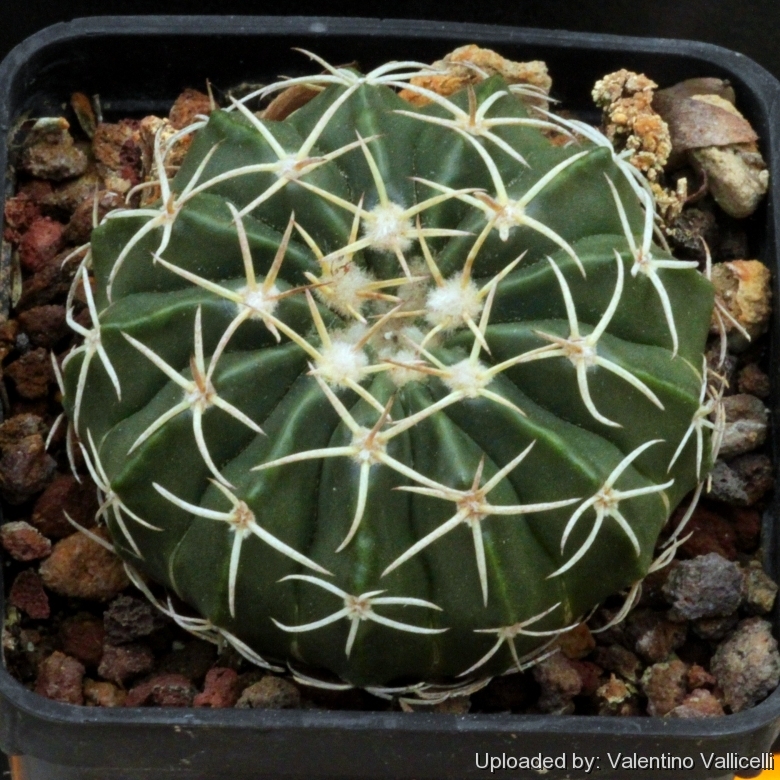Donate now to support the LLIFLE projects.
Your support is critical to our success.
Your support is critical to our success.
= Wigginsia sessiliflora (Hook.) D.M.Porter
Taxon 13: 210 1964. (sessiflora).
Accepted Scientific Name: Parodia sellowii (Link & Otto) D.R.Hunt
Cactaceae Consensus Init. 4: 6. 1997 [Oct 1997]

Wigginsia sessiflora (Wigginsia sessiliflora) Photo by: Valentino Vallicelli
Synonyms:
- Wigginsia sessiliflora (Hook.) D.M.Porter
- Echinocactus sessiliflorus Hook.
- Malacocarpus sessiliflorus (Hook.) Backeb.
- Notocactus sessiliflorus (Hook.) Krainz
- Wigginsia sessiflora (Hook.) D.M.Porter
See all synonyms of Parodia sellowii
back
Accepted name in llifle Database:Parodia sellowii (Link & Otto) D.R.Hunt
Cactaceae Consensus Init. 4: 6. 1997 [Oct 1997]
Synonymy: 109
- Parodia sellowii (Link & Otto) D.R.Hunt
- Echinocactus acuatus var. sellowii Speg.
- Echinocactus sellowii Link & Otto
- Echinocactus sellowii var. typicus Gürke
- Malacocarpus sellowianus Salm-Dyck
- Malacocarpus sellowii (Link & Otto) K.Schum.
- Melocactus sellowii Link & Otto
- Notocactus sellowii (Link & Otto) S.Theun.
- Wigginsia sellowii (Link & Otto) F.Ritter
- Parodia paucicostata (F.Ritter) F.H.Brandt ex Weskamp
- Wigginsia beltranii Frič ex Z.Fleisch. & Schütz
- Malacocarpus beltranii Frič
- Notocactus beltranii (Frič ex Z.Fleisch. & Schütz) G.Schäf.
- Notocactus sellowii var. beltranii (Frič) Neduchal
- Wigginsia bezrucii (Frič) Z.Fleisch. & Schütz
- Malacocarpus bezrucii var. Frič Frič
- Notocactus sellowii var. bezrucii (Frič) Neduchal
- Wigginsia bezrucii var. centrispina (Frič) Z.Fleisch. & Schütz
- Malacocarpus bezrucii var. centrispinus Frič
- Notocactus bezrucii var. centrispinus (Frič) S.Theun.
- Notocactus sellowii f. centrispinus (Frič) Neduchal
- Wigginsia corniger (Frič) Z.Fleisch. & Schütz
- Malacocarpus bezrucii var. corniger Frič
- Notocactus bezrucii var. corniger (Frič) S.Theun.
- Notocactus sellowii f. corniger (Frič) Neduchal
- Wigginsia bezrucii var. corniger (Frič) Z.Fleisch. & Schütz
- Wigginsia corynodes (Otto ex Pfeiff.) D.M.Porter
- Echinocactus acuatus var. corynodes (Otto ex Pfeiff.) Speg.
- Echinocactus corynodes Otto ex Pfeiff.
- Malacocarpus corynodes (Otto ex Pfeiff.) Salm-Dyck
- Notocactus acuatus var. corynodes (Otto ex Pfeiff.) Havlíček
- Notocactus corynodes (Otto ex Pfeiff.) Krainz
- Notocactus erinaceus f. corynodes (Otto ex Pfeiff.) N.Gerloff
- Wigginsia courantii (Lem.) F.Ritter
- Echinocactus courantii Lem.
- Echinocactus sellowii var. courantii (Lem.) Gürke
- Malacocarpus courantii (Lem.) Salm-Dyck
- Malacocarpus sellowii var. courantii (Lem.) Backeb. & F.M.Knuth
- Notocactus courantii (Lem.) S.Theun.
- Notocactus erinaceus subvar. courantii (Lem.) G.Schäf., G.Schäf.
- Notocactus sellowii var. courantii (Lem.) N.Gerloff
- Notocactus sellowii f. courantii (Lem.) N.Gerloff & Neduchal
- Wigginsia fricii (Arechav.) D.M.Porter
- Echinocactus fricii Arechav.
- Eriocactus fricii Arechav.
- Malacocarpus fricii (Arechav.) A.Berger
- Notocactus fricii (Arechav.) Krainz
- Notocactus sellowii f. fricii (Arechav.) N.Gerloff
- Wigginsia leucocarpa (Arechav.) D.M.Porter
- Malacocarpus leucocarpus (Arechav.) Backeb.
- Notocactus acuatus var. leucocarpus (Arechav.) Havlíček
- Notocactus leucocarpus (Arechav.) G.Schäf.
- Notocactus sellowii f. leucocarpus (Arechav.) N.Gerloff
- Wigginsia macracantha (Arechav.) D.M.Porter
- Echinocactus macrocanthus Arechav.
- Echinocactus sellowii var. macracanthus Arechav.
- Echinocactus sellowii f. macracanthus (Arechav.) Schelle
- Malacocarpus macracanthus (Arechav.) Herter
- Malacocarpus sellowii var. macrocanthus (Arechav.) Backeb. & F.M.Knuth
- Notocactus macracanthus (Arechav.) G.Schäf.
- Notocactus sellowii var. macracanthus (Arechav.) S.Theun.
- Notocactus sellowii f. macracanthus (Arechav.) N.Gerloff
- Wigginsia sellowii var. macracantha (Arechav.) F.Ritter
- Wigginsia macrogona (Arechav.) D.M.Porter
- Echinocactus macrogonus (Arechav.) Borg
- Echinocactus sellowii var. macrogonus Arechav.
- Echinocactus sellowii f. macrogonus (Arechav.) Schelle
- Malacocarpus macrogonus (Arechav.) Herter
- Malacocarpus sellowii var. macrogonus (Arechav.) Backeb. & F.M.Knuth
- Notocactus macrogonus (Arechav.) G.Schäf.
- Notocactus sellowii f. macrogonus (Arechav.) Havlíček
- Wigginsia pauciareolata (Arechav.) R.Kiesling
- Echinocactus pauciareolatus Arechav.
- Malacocarpus pauciareolatus (Arechav.) A.Berger
- Notocactus pauciareolatus (Arechav.) Krainz
- Notocactus sellowii f. pauciareolatus (Arechav.) N.Gerloff
- Wigginsia sesseliflora var. pauciareolata (Arechav.) Y.Itô
- Wigginsia rubricostata Frič ex Z.Fleisch. & Schütz
- Malacocarpus rubricostatus Frič
- Notocactus rubricostatus (Z.Fleisch. & Schütz) G.Schäf.
- Notocactus sellowii f. rubricostatus (Z.Fleisch. & Schütz) N.Gerloff in N.Gerloff, Neduchal & S.Stuchlik
- Wigginsia sessiliflora (Hook.) D.M.Porter
- Echinocactus sessiliflorus Hook.
- Malacocarpus sessiliflorus (Hook.) Backeb.
- Notocactus sessiliflorus (Hook.) Krainz
- Wigginsia sessiflora (Hook.) D.M.Porter
- Wigginsia sessiliflora var. martinii (Labour. ex Rümpler) D.M.Porter
- Echinocactus martinii (Labour. ex Rümpler) Cels ex K.Schum.
- Echinocactus sellowii var. martinii (Labour. ex Rümpler) K.Schum.
- Echinocactus sellowii f. martinii (Labour. ex Rümpler) Schelle
- Malacocarpus martinii Labour. ex Rümpler
- Malacocarpus sellowii var. martinii (Labour. ex Rümpler) Backeb. & F.M.Knuth
- Malacocarpus sessiliflorus var. martinii (Labour. ex Rümpler) Backeb.
- Wigginsia stegmannii (Backeb.) D.M.Porter
- Malacocarpus stegmannii Backeb.
- Notocactus sessiliflorus var. stegmannii (Backeb.) Havlíček
- Notocactus stegmannii (Backeb.) Krainz
- Wigginsia tephracantha (Link & Otto) D.M.Porter
- Echinocactus tephracanthus Link & Otto
- Malacocarpus tephracanthus (Link & Otto) K.Schum.
- Melocactus tephracanthus Link & Otto
- Notocactus erinaceus var. tephracanthus (Link & Otto) Krainz
- Notocactus sellowii f. tephracanthus (Link & Otto) Neduchal
- Notocactus tephracanthus (Link & Otto) Krainz
- Trichocereus tephracanthus (Link & Otto) Borg
- Wigginsia vorwerkiana (Werderm. ex Backeb.) D.M.Porter
- Echinocactus vorwerkianus Werderm.
- Malacocarpus vorwerkianus (Werderm.) Backeb.
- Notocactus sessiliflorus f. vorwerkianus (Werderm.) Neduchal
back
| Your Actions | |
|---|---|
| Back to Wigginsia index | |
| Back to Cactaceae index | |
 |
Back to Cacti Encyclopedia index |








